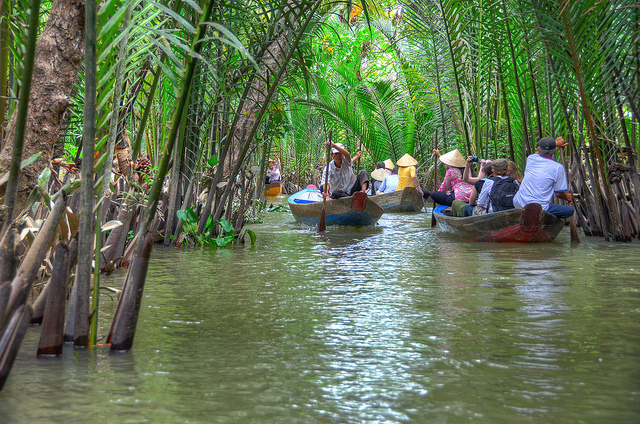Endowed with the charming natural scenery, Thoi Son islet in the Mekong Delta province of Tien Giang now becomes an ecotourism site. However, few people know that today’s Thoi Son is thanks to the endless efforts of local people to develop the isolated isle into one of the region’s go-to destinations.

Thoi Son islet, also called Lan or unicorn islet, covers more than 10 square kilometres in My Tho city. This island is not just a well-known attraction in the Mekong River Delta, but also a famous growing fruit area with the population of about 6,000 people. The island receives alluvial from Tien River. Here naturally beautiful scenery converges upon the cultural identities of the southern region.
Thoi Son is now a must-see destination in the south, thanks to local residents’ efforts to use the area’s natural features to develop tourism.
“When I moved to get married, this area was submerged under water,” Do Thi Tu, a boatwoman in Thoi Son tourism site said, adding that water level even reached the house ceiling. “Since tourism has gained popularity, many people have come here to earn a living through offering tourism services,” she said.
Thoi Son is considered a green tourism area and welcomes more than 400,000 tourists every year, including 300,000 from abroad.
Nor Suriani Razak, a Malaysian tourist who was curious to explore Viet Nam after so many of his friends told him about the waterway tours around the country. “Sure enough, I’m impressed by the waterway scenery and food here, especially the fruits,” he said.
Tourists can experience the waterway scenery of the Mekong Delta by taking a trip on a sampan, one of the typical vehicles in the southern region.
Raised by the silts of the Tien river, Thoi Son is able to grow groves of luxuriant fruit trees.
Visiting the gardens here means appreciating southern fruit specialties, sipping a cup of warm tea, and enjoying “Don ca tai tu”, or amateur singing, one of Viet Nam’s intangible cultural heritage features recognised by UNESCO.
Le Van Son, a local farmer, said his fruit garden receives hundreds of visitors both from home and abroad. “To lure visitors, we have improved our service quality, offered more fresh fruits as well as Don ca tai tu tunes,” according to Son.
Some traditional handicrafts associated with tourism are booming here. Particularly, bee-keeping always attracts the attention of tourists, tasting the special honey sweetness.
For Nguyen Anh Tuan, a tourist from Ha Noi, a tour to Thoi Son left deep impression on him. “It is unforgettable. Despite stopping for a while, I feel how considerate the local people are, they’re not too focused on the profits from offering services,” Tuan said.
Traditional coconut candy-making also intrigues visitors who cannot resist the fragrant aroma of freshly-made candy.
Tourism has been further boosted on the isle since Rach Mieu bridge opened, connecting Tien Giang with Ben Tre province.
Tourism here has generated more jobs for local people. Dozens of stopovers and souvenir shops have been opened, helping improve locals’ income and living standards. Thanks to tourism, many of the previously poor islanders have jobs and have gradually stabilised their life.
It takes about one hour to get here from Ho Chi Minh City. Its close proximity to the southern hub offers high potentials for Thoi Son to become a major tourism site in the Mekong Delta.
The Viet Nam National Administration of Tourism has proposed the Government recognise Thoi Son and Tan Long islets as national tourism areas.
Overall, what has most impressed visitors is the hospitality of locals along with fresh fruits and Don ca tai tu tunes.